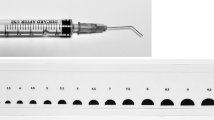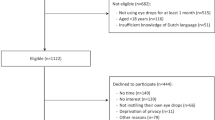Abstract
Objective
To evaluate the effectiveness in reducing pain by giving oral sucrose and non-pharmacological comfort measures prior to topical administration of mydriatic eye drops on premature infants undergoing retinopathy of prematurity (ROP) screening eye exams in a neonatal intensive care unit (NICU).
Study design
A prospective quality improvement study was conducted in the NICU where infants were given oral sucrose prior to administration of mydriatic eye drops while a second person performed facilitated tucking and containment. Premature Infant Pain Profile (PIPP) scores were recorded during eye drop administration and compared to a group that did not receive any comfort measures.
Result
Sixty-eight infants were enrolled. Mean PIPP scores increased an average of 1.5 (SD = 1.5) during administration of mydriatic drops without comfort measures compared to 0.6 (SD = 0.8) when comfort measures were used. This difference was statistically significant (p < 0.001).
Conclusions
Oral sucrose and simple comfort measures can be effective in reducing pain associated with mydriatic eye drops.
This is a preview of subscription content, access via your institution
Access options
Subscribe to this journal
Receive 12 print issues and online access
$259.00 per year
only $21.58 per issue
Buy this article
- Purchase on Springer Link
- Instant access to full article PDF
Prices may be subject to local taxes which are calculated during checkout



Similar content being viewed by others
References
Good WV, Hardy RJ, Dobson V, Palmer EA, Phelps DL, Quintos M, et al. The incidence and course of retinopathy of prematurity: findings from the early treatment for retinopathy of prematurity study. Pediatrics. 2005;116:15–23.
Belda S, Pallás CR, de la Cruz J, Tejada P. Screening for retinopathy of prematurity: is it painful? Neonatology. 2004;86:195–200.
Kirchner L, Jeitler V, Pollak A, Mullner-Eidenbock A, Weinzettel R, Kraschl R, et al. Must screening examinations for retinopathy of prematurity necessarily be painful? Retina. 2009;29:586–91.
Mitchell AJ, Green A, Jeffs DA, Roberson PK. Physiologic effects of retinopathy of prematurity screening examinations. Adv Neonatal Care. 2011;11:291–7.
Cohen AM, Cook N, Harris MC, Ying G-s, Binenbaum G. The pain response to mydriatic eye drops in preterm infants. J Perinatol. 2013;33:462–5.
Hassler-Hurst J, Wadham C, Rayman G. A double-blind study comparing 0.5% and 1% tropicamide for annual retinal screening in diabetic adolescents. Diabet Med. 2004;21:434–9.
Lim DL, Batilando M, Rajadurai VS. Transient paralytic ileus following the use of cyclopentolate-phenylephrine eye drops during screening for retinopathy of prematurity. J Paediatr Child Health. 2003;39:318–20.
Mitchell A, Hall RW, Erickson SW, Yates C, Hendrickson H. Systemic absorption of cyclopentolate and adverse events after retinopathy of prematurity exams. Curr Eye Res. 2016;41:1601–7.
Lee JM, Kodsi SR, Gaffar MA, Rubin SE. Cardiopulmonary arrest following administration of Cyclomydril eyedrops for outpatient retinopathy of prematurity screening. J AAPOS. 2014;18:183–4.
Lees BJ, Cabal LA. Increased blood pressure following pupillary dilation with 2.5% phenylephrine hydrochloride in preterm infants. Pediatrics. 1981;68:231–4.
Stevens B, Johnston C, Franck L, Petryshen P, Jack A, Foster G. The efficacy of developmentally sensitive interventions and sucrose for relieving procedural pain in very low birth weight neonates. Nurs Res. 1999;48:35–43.
Young TE. Pharmacology review. NeoReviews. 2003;4:e163.
Taddio A, Shah V, Shah P, Katz J. Beta-endorphin concentration after administration of sucrose in preterm infants. Arch Pediatr Adolesc Med. 2003;157:1071–4.
Eriksson M, Finnstrom O. Can daily repeated doses of orally administered glucose induce tolerance when given for neonatal pain relief? Acta Paediatr. 2004;93:246–9.
Fierson WM, American Academy of Pediatrics Section on Ophthalmology; American Academy of Ophthalmology; American Association for Pediatric Ophthalmology and Strabismus; American Association of Certified Orthoptists. Screening examination of premature infants for retinopathy of prematurity. Pediatrics. 2018;142(6):e20183061. Pediatrics. 2019;143:e20183810.
Grabska J, Walden P, Lerer T, Kelly C, Hussain N, Donovan T, et al. Can oral sucrose reduce the pain and distress associated with screening for retinopathy of prematurity? J Perinatol. 2005;25:33–35.
O’Sullivan A, O’Connor M, Brosnahan D, McCreery K, Dempsey EM. Sweeten, soother and swaddle for retinopathy of prematurity screening: a randomised placebo controlled trial. Arch Dis Child Fetal Neonatal Ed. 2010;95:F419–422.
Kandasamy Y, Smith R, Wright IMR, Hartley L. Pain relief for premature infants during ophthalmology assessment. J Am Assoc Pediatr Ophthalmol Strabismus. 2011;15:276–80.
Sun X, Lemyre B, Barrowman N, O’Connor M. Pain management during eye examinations for retinopathy of prematurity in preterm infants: a systematic review. Acta Paediatr. 2010;99:329–34.
Rush R, Rush S, Ighani F, Anderson B, Irwin M, Naqvi M. The effects of comfort care on the pain response in preterm infants undergoing screening for retinopathy of prematurity. Retina. 2005;25:59–62.
Stevens B, Johnston C, Petryshen P, Taddio A. Premature infant pain profile: development and initial validation. Clin J Pain. 1996;12:13–22.
Ballantyne M, Stevens B, McAllister M, Dionne K, Jack A. Validation of the premature infant pain profile in the clinical setting. Clin J Pain. 1999;15:297–303.
Stevens B, Yamada J, Ohlsson A, Haliburton S, Shorkey A. Sucrose for analgesia in newborn infants undergoing painful procedures. Cochrane Database Syst Rev. 2016;7:Cd001069.
Blass EM, Shah A. Pain-reducing properties of sucrose in human newborns. Chem Senses. 1995;20:29–35.
Johnston CC, Stremler R, Horton L, Friedman A. Effect of repeated doses of sucrose during heel stick procedure in preterm neonates. Biol Neonate. 1999;75:160–6.
Grunau RE. Neonatal pain in very preterm infants: long-term effects on brain, neurodevelopment and pain reactivity. Rambam Maimonides Med J. 2013;4:e0025.
Schwaller F, Fitzgerald M. The consequences of pain in early life: injury-induced plasticity in developing pain pathways. Eur J Neurosci. 2014;39:344–52.
Valeri BO, Holsti L, Linhares MB. Neonatal pain and developmental outcomes in children born preterm: a systematic review. Clin J Pain. 2015;31:355–62.
Farkouh A, Frigo P, Czejka M. Systemic side effects of eye drops: a pharmacokinetic perspective. Clin Ophthalmol. 2016;10:2433–41.
Acknowledgements
We thank the nurses and staff at the Alberta Children’s Hospital (Calgary, AB).
Author information
Authors and Affiliations
Contributions
DNW designed the study, collected data, analyzed the data, and wrote the manuscript. KL designed the study, collected data, analyzed the data, created figures, and helped to write the manuscript. SD, AH, VH, and SAD designed the study, collected data, and helped write the manuscript.
Corresponding author
Ethics declarations
Conflict of interest
The authors declare that they have no conflict of interest.
Additional information
Publisher’s note Springer Nature remains neutral with regard to jurisdictional claims in published maps and institutional affiliations.
Supplementary information
Rights and permissions
About this article
Cite this article
Wang, D.N., Lavery, K., Dalgleish, S. et al. Reducing discomfort of eye drops prior to retinal examination in the neonatal intensive care unit. J Perinatol 40, 1857–1862 (2020). https://doi.org/10.1038/s41372-020-00852-3
Received:
Revised:
Accepted:
Published:
Issue Date:
DOI: https://doi.org/10.1038/s41372-020-00852-3



